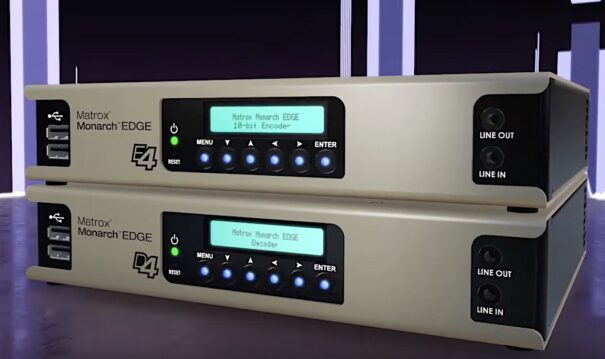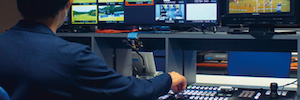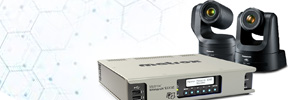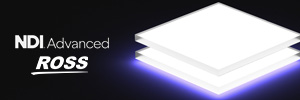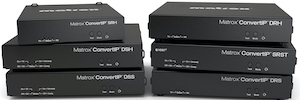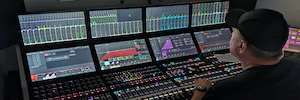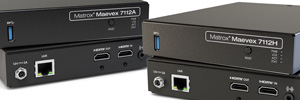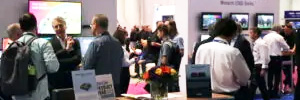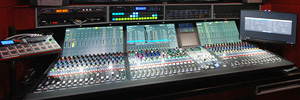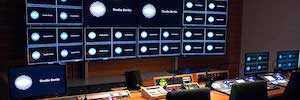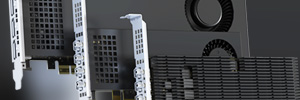Lakeland PBS saves time and money with REMI production thanks to Matrox Monarch EDGE.
Minnesota’s public PBS affiliate, Lakeland PBS, which produces, acquires, and broadcasts programs relevant to the rural and culturally diverse region it serves, opts for a pair of ماتروكس Monarch EDGE E4 encoders and a D4 decoder to send content between two remote locations.
When Lakeland PBS produces the live-to-tape show تيارات ليكلاند at its satellite station in Brainerd, staff members from headquarters travel to the satellite location to record the show and bring the storage drive back to HQ. At about 200 miles and four hours round trip plus production time, that’s a costly undertaking this broadcaster can ill afford because of limited cash and limited staff.
broadcast equipment
To save money and time and bridge the distance between locations, Lakeland PBS must be able to send recorded content from the remote studio to the headquarters in Bemidji over VPN.
Lakeland PBS needed an encoding/decoding solution that would reliably deliver the video signal with good quality and subsecond latency. The broadcaster had considered using PC-based solutions with SDI add-in cards to perform the encoding and transport operations. During testing, the solution worked perfectly sometimes, but not every time. Lakeland PBS determined that this solution wasn’t robust enough to traverse its VPN, so a purpose-built SRT encoder would be the ideal solution.
Since stability is a big consideration for remote deployment, Lakeland PBS went in search of hardware encoding that would make its SRT-driven REMI workflow a reality.
The solution
Lakeland PBS chose a Matrox Monarch EDGE E4 encoder and د4 decoder pair to send content between the two locations.
“The other option we tested should have worked, but it just didn’t quite work. No matter how low we set the bit rate, the transmission wasn’t reliable enough. It’s got to work all the time if you’re going to do a show with it,” said توم وايلد, director of engineering at Lakeland PBS. “Adding this SRT encoder definitely was the secret sauce that made reliable video streams and remote production possible.”
In the REMI workflow, the Monarch EDGE encoder in the remote location takes three 1080i 60 streams from the station’s باناسونيك PTZ cameras and transmits the three feeds to headquarters over the VPN as one stream with embedded audio. At HQ, the Monarch EDGE decoder feeds SDI 1080i 59.94 with embedded audio to the station’s Ross Video production switcher.
Besides remote production on the live-to-tape shows, Lakeland PBS can also use the Monarch EDGE solution for other remote production purposes, like live hits for nightly newscasts. The broadcaster also appreciates EDGE’s talkback functionality, which makes it possible to do intercom through the same box as the encoding/decoding. That capability to communicate with staff was especially helpful when the station covered live debates. And even on remote productions, an IFB makes it possible for someone at HQ to talk to a host at the satellite station.
Results
With the Monarch EDGE solution, staff members at headquarters can use their production infrastructure to switch studio productions at the satellite location 100 miles away.
Lakeland PBS has been using the Monarch EDGE encoder and decoder since January 2022, and the pair consistently delivers rock-solid video transmission with good-quality encoding and latency of less than 250 milliseconds from SDI in to SDI out. It is this reliability that makes the broadcaster’s REMI workflow possible.
Eliminating travel also gives staff a better work-life balance. People can do their work from the headquarters station, which means they don’t have to leave home extra early to arrive at the remote site on time or get home late because of a long drive. It also alleviates the stress of travel, especially in the middle of a Minnesota winter, when the journey can be treacherous.
Having a reliable encoding solution also makes it possible for Lakeland PBS to produce more local relevant content for more of its viewers, who, unlike with a metropolitan PBS station, are spread out over a large coverage area.
“We’re a pretty small rural PBS station, so every dollar matters. We want to cater to our whole coverage area and make things local and meaningful to our viewers, which can get expensive when our viewing areas are a hundred miles apart,” Wild said. “The finances of that being what they are, this technology makes it possible to fulfill that goal. We can say yes to certain shows when we don’t have to add another half-day and all the expenses to make it happen.”
هل أعجبك هذا المقال؟
اشترك في موقعنا تغذية ار اس اس ولن تفوت أي شيء.



